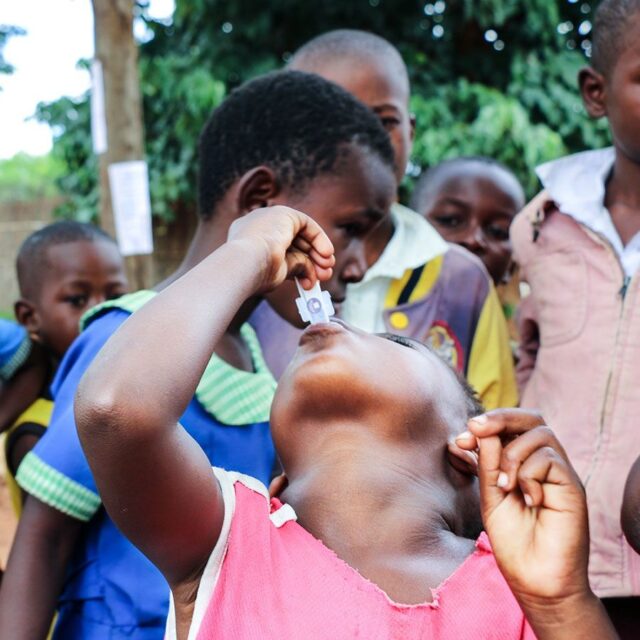…Global oral cholera vaccine (OCV) supply could enable largescale preventive vaccination by 2026 – but urgent action is needed to achieve this goal.
…In an alarming trend, approximately 10 million more vaccines needed for outbreak response through 2021 and 2022 than the entire previous decade combined.
MON, MAY 22 2023-theGBJournal | Gavi, the Vaccine Alliance today published a roadmap -(Gavi Alliance MS Roadmap for Oral Cholera Vaccines) outlining critical actions needed to ensure supply of oral cholera vaccine (OCV) is able to meet growing demand from countries.
Released against a backdrop of a recent wave of cholera outbreaks around the world, the roadmap forecasts the short-, mid- and long-term outlook for global cholera vaccine supply. Developed in consultation with a range of key Alliance partners, including WHO, UNICEF, the Global Taskforce for Cholera Control (GTFCC), and the Bill and Melinda Gates Foundation (BMGF), it describes how these organizations, manufacturers and countries can work together towards ensuring global OCV supply can support largescale preventive vaccination by 2026.
“Cholera vaccines have steadily become more available over the past decade, meeting rising country demand,” said Dr Derrick Sim, Managing Director for Vaccine Markets and Health Security at Gavi. “But what many people do not realize is that every vaccine dose delivered to a person in need today is the result of years of planning, investment and coordination. As a result, the good news is we have doses to meet all emergency demand despite the rise in outbreaks, and that is expected to continue. But this trend underscores the increasing importance of preventing outbreaks before they occur. The ultimate solution to both sustainable OCV supply and cholera control lies in our collective ability to step up our efforts on prevention programmes.”
The roadmap outlines three areas where partners will work together to ensure supply is available to fully support both outbreak response and longer-term preventive vaccination:
In the short-term, optimize supply usage and availability: Alliance partners will work together to provide countries with updated guidance on best use of OCV in emergency response – to improve the planning of campaigns and optimize use of doses.
To provide consistency in demand, and transparency and equity in how doses will be distributed to countries in need for preventive vaccination, the development of an allocation framework is vital. In parallel, Gavi is working to support new suppliers to enter the market more quickly and with higher volumes, and with the main current supplier, EuBiologics, to increase production capacity.
Ensure demand for preventive vaccination: In order for supply to meet demand for preventive OCV programmes by 2026, countries and partners must keep planning well in advance for these programmes.
Both actions are interrelated: predictable and forecastable demand will provide suppliers with accurate signals to ensure the necessary investments are made now to secure future supply, and this security of future supply can guide countries’ preventive cholera plans.
The roadmap outlines the range of technical guidance and support needed to ensure countries can accurately map high-risk areas for cholera and plan high quality, impactful, multi-sectoral, long-term preventive programs.
Support high-impact vaccine and delivery innovations: With multiple cholera vaccine candidates in development, it is vital that clear signals are sent on the product innovations that would be most impactful in lower-income countries where these vaccines are most needed (such as higher- and longer-lasting protection in children and adults) and how they should be prioritized.
Clear protocols and labelling for how long vaccines can be kept outside the cold chain in a campaign or emergency response situation (also known as “controlled temperature chain”, or CTC) would greatly increase usability in lower-income country settings and thus ability to reach those most in need.
Alarming trends underscore need for outbreak prevention
Climate change, conflict, and displacement have all contributed to a recent alarming rise in cholera outbreaks, with 30 countries reporting cases or outbreaks in 2022.
This trend, coupled with countries’ increased interest in using OCV for cholera control among other disease control measures, has put a strain on OCV supply, with demand for emergency response spiking. From 2011-2020, approximately 38 million doses of OCV were used globally in response to cholera outbreaks. In 2021 and 2022, the wave of cholera outbreaks meant that nearly 48 million doses were needed for emergency response in those two years alone.
In response, the international coordinating body that manages how the Gavi-funded global stockpile of oral cholera vaccines is used for outbreak response recommended a temporary shift to a 1 dose strategy for outbreaks – aligned with WHO recommendations – to ensure that available supply can continue to meet countries’ emergency OCV needs.
In the first five years of preventive vaccination with OCV, from 2016 to 2020, roughly half of supply available in the global OCV stockpile was dedicated to preventive campaigns. While the rise in emergency OCV use has slowed this work over the last two years as available doses were prioritized for emergency response, it has also further underscored the urgent need for preventive vaccination in cholera hotspots.
Gavi and GTFCC partners have supported ad hoc preventive campaigns in 13 countries to-date, generating vital learnings that are being leveraged to plan for multiyear preventive cholera vaccination programmes, which are expected to significantly contribute to cholera control in endemic hotspots while longer-term control measures, such as clean water, improved sanitation, and improved surveillance, are put in place.
In 2023, Gavi officially launched its multi-year preventive OCV programme support window, with the first countries expected to apply later this year.
Forecasting the future of OCV supply
A core pillar of Gavi’s model is helping shape vaccine markets, coordinating stakeholders and investing to ensure vaccines that meet lower-income countries’ needs are developed, reliably available and affordable. The availability of oral cholera vaccines has risen sharply in the last decade, from around 4 million doses available globally in 2012 to 35 million doses in 2022, thanks to targeted investments from Gavi, BMGF and partners in the funding and establishment of the global OCV stockpile, as well as support for increasing manufacturer capacity.
In the short-term, the roadmap forecasts that global supply will increase by the end of 2025, due to investments by EuBiologics, Gavi and BMGF in the development of vaccines that can be produced in higher volumes, and the expected entry of a new manufacturer. However, if the current trend in outbreaks continues, supply for preventive vaccination will likely continue to be limited during this period, and will need to be allocated transparently and equitably.
By 2026, the roadmap forecasts that supply will start to meet demand for preventive vaccination, thanks to investments in increased capacity and additional manufacturers entering the market. This will enable large-scale preventive OCV campaigns in cholera-endemic countries. The pattern of cholera disease and outbreaks in the longer term, as well as ongoing vaccine needs, will likely depend on the success of cholera control measures, including investments in water, sanitation, and hygiene infrastructure, as well as preventive vaccination.
Twitter-@theGBJournal|Facebook-the Government and Business Journal|email:gbj@govbusinessjournal.com| govandbusinessj@gmail.com










